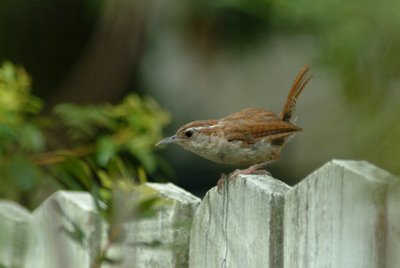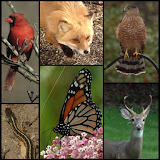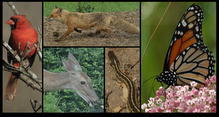Carolina Wren Sings
 In my opinion, the best voice in the Habitat is that of the Carolina Wren. This evening, one of the wrens decided to perch on the sundial and sing and sing and sing. In the first photo, you can ‘see’ the singing – the open beak. The wren’s throat will visibly vibrate as he sings. Back in June, one of the wrens perched on the handrail to the porch steps and serenaded my daughter and me for about 30 minutes. I am sorry that I cannot point you to an audio link where you can hear a wren. It is rare that you cannot hear one of the wrens during any one hour period in the Habitat.
In my opinion, the best voice in the Habitat is that of the Carolina Wren. This evening, one of the wrens decided to perch on the sundial and sing and sing and sing. In the first photo, you can ‘see’ the singing – the open beak. The wren’s throat will visibly vibrate as he sings. Back in June, one of the wrens perched on the handrail to the porch steps and serenaded my daughter and me for about 30 minutes. I am sorry that I cannot point you to an audio link where you can hear a wren. It is rare that you cannot hear one of the wrens during any one hour period in the Habitat.
Every once in a while, a wren will pose for me as in this second photo. Similar in size and coloring to the sparrow, I know that I am looking at a wren by the upright cocked tail and the bold white eye stripe. I have to confess that the first time I identified a wren in the Habitat was by looking at a photo and realizing that what I had in the photo was not a sparrow. Most of the time, the wrens are on the ground poking through the mulch or under the shrubs for inserts, as in the third photo. They are very inquisitive birds interested in exploring any nook or cranny. Last May, I was on the porch photographing bird visitors with one of the windows open (better than photographing through the glass). A few minutes after stepping back into the house, I heard from the kitchen noise and returned to a wren inside the porch. He was quite upset at not being able to find his way out. Silly me, instead of picking up the camera, I opened more windows. The wren quickly found a way out. Although they are supposed to be attracted by suet (and really only showed up in the Habitat after I added suet to the feeders), I have never seen a wren at the suet feeder. Most of the time, they pick up sunflower seeds that fall on the ground, and rarely at the sunflower feeder.
Most of the time, the wrens are on the ground poking through the mulch or under the shrubs for inserts, as in the third photo. They are very inquisitive birds interested in exploring any nook or cranny. Last May, I was on the porch photographing bird visitors with one of the windows open (better than photographing through the glass). A few minutes after stepping back into the house, I heard from the kitchen noise and returned to a wren inside the porch. He was quite upset at not being able to find his way out. Silly me, instead of picking up the camera, I opened more windows. The wren quickly found a way out. Although they are supposed to be attracted by suet (and really only showed up in the Habitat after I added suet to the feeders), I have never seen a wren at the suet feeder. Most of the time, they pick up sunflower seeds that fall on the ground, and rarely at the sunflower feeder.




No comments:
Post a Comment